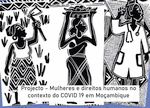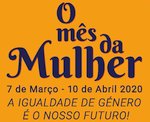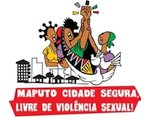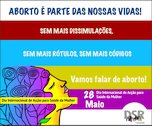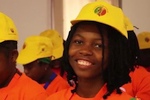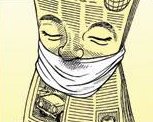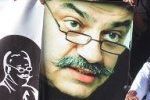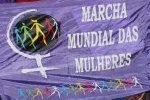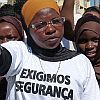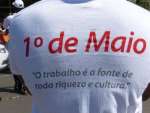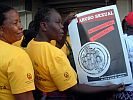Family Dynamics and Perceptions of Poverty and Gender in Mozambique
Ana Loforte
Introduction
The purpose of this article is to look at perceptions of poverty in the light of gender structures, based on research done by DAA1. The target focus groups for interviews were women and men, households headed by orphans or that included orphans, male headed households, female headed households and also households of recent immigrants, always taking care to ensure gender equilibrium – intentionally, in order to include different levels of stratification.
As social relations have a strong effect on human action, the unit of analysis was the household in all its dynamic aspects and as a decision-making space in the context of these same relations. As a backdrop, there was also the idea that the way the family is constituted, is based on a relational and hierarchical view of the world.
The strategy used was to make an inventory of the households’ networks of kinship and neighbours, as these networks comprise forms of social organization in the places studied. This differentiated framework of different informants made the analysis complex and provided more information that permitted a broader construction of the context surrounding the informants.
We are looking at families within communities and their networks, where the concept of poverty acquires a variety of usages and itineraries. According to Geertz (1998) the act of classifying the world, of building, for example, a concept such as poverty, becomes an act of trading the symbolic forms available in communities. We think that, in order to explain customs, the coming and going of this traffic, we must analyze the communities within which the symbolic forms are available. In the case proposed by Geertz, this analysis does not necessarily mean describing their social structure, but rather concentrating on the norms that organize them and put them in touch with others.
Care was also taken to include the experience of women, in order to reveal other dimensions of the reality from which they are usually excluded. This is because, as relatively marginal informants, they reflect more on the society where they live, their social rules and standards, precisely because they often question them. With this in mind, we sought to develop an approach that tried to understand how men and women produce and take ownership of models that explain categories of poverty, based on their concrete social experience.
The theoretical approach focuses on the fact that individuals act and respond according to their emic2 perceptions of their socio-economic position and that social asymmetries are relevant dimensions of structure and action (Bourdieu, 1990).
The analysis of the data collected was based on the concept that relations between men and women are socially built, constantly negotiated power relations, and this results in sharing, inequalities and differences. When incorporating the gender category, the social and symbolic dimension of the difference was emphasized, in order to be able to deconstruct male/female polarity and make these notions plural. (Butler, 2001; Scott, 1988).
Some initiatives to fight poverty in Mozambique
Absolute Poverty Reduction Action Plans (PARPA)
The most recent history of government initiatives to fight poverty dates back to the early 80s and the “Social Dimensions of Structural Adjustment” programme. However, the first national survey of poverty and well-being, known as IAF, took place in 1996-97 and its main emphasis was to identify the scarcity of household resources, in a period of large population movements, as a substantial part of displaced people and refugees were returning home after the war. It found that roughly 70% of the Mozambican population was living below the poverty line. A second survey of the same kind (IAF 2002-2003) revealed that national poverty had fallen to 54%.
As part of a global strategy to fight poverty, PARPA I was prepared after the IAF. PARPA I was a national and multi-sectoral medium-term (i.e. five years) planning instrument that emphasized the social sectors. It emerged as a complement to the government program and other short-term instruments, but also as an indicator of Mozambique’s foreign economic policy, as the vehicle for cooperation and dialogue intended to mobilize the resources of international partners and negotiate debt relief in the context of strategies to fight poverty.
However, despite the growing feminization of poverty due to social inequalities, the objective of gender equality was still not properly addressed in the PARPA. The document did not reflect gender and power disparities in Mozambican societies and did not contain specific interventions intended to strengthen women’s rights. There were, however, efforts to overcome these gaps and some women’s organizations, such as Forum Mulher, the Gender Coordination Group and the Ministry for Women and Social Action (MMAS), sought to influence the preparation of indicators that incorporated gender aspects.
The objective of PARPA II (2006-2009) was to reduce the incidence of poverty from 54% in 2003 to 45% in 2009. Like the previous plan, its priority areas are the development of human capital through education and health, improving governance, the development of basic infrastructure and agriculture, rural development and improving macro economic and financial management. Based on three pillars (governance, human capital and economic development) it focuses on increasing the standard of living of the poorest and the most needy populations living in absolute poverty.
PARPA II presents poverty as the (im)possibility – due to inability or a lack of opportunity – of individuals, families and communities to gain access to conditions considered minimum in the light of society’s norms. This new definition shows a different perception, far from the vision of the poor as passive in the active fight against poverty, with a redefinition of the poor as agents and subjects of their own development but who lack opportunities3. There are also alternative and broader definitions of aspects not just related to the absence of an income, but also the absence of access to basic resources such as education, health, water and sanitation, energy etc.
Perceptions of poverty and its dimensions
In this part we intend to explore the perceptions of individuals and their discourse on poverty. It was found that these perceptions are varied and that ideas are based in particular on their own experiences of poverty and how they cope with it in their daily lives. As a result, discourse on it varies from individual to individual.
Responses are varied and indicate that there is a difference between poverty that affects the community and poverty that affects the family or individual. The former emphasize various factors, with priority for lack of services and basic infrastructure, which are external and structural but which affect the individuals who use them. The latter emphasize internal factors related in particular to the perception of poverty of each family/individual.
It should also be noticed that these perceptions have many aspects: they are genderised and have local and regional dimensions, which complicates the idea that there is just one collective concept of poverty that we can use.
As regards individuals, being poor is considered to be the result of at least four situations: (i) lack of money, sources of income and essential goods; (ii) lack of social capital; (iii) precarious health and few educational opportunities; (iv) lack of consumer goods and poor access to productive resources. We shall only analyze some of these perceptions, but it must be stressed that this categorization is marked simultaneously by mapping out a set of material, financial and political goods and services. For the respondents, easy or difficult access to them determine who must be understood as belonging to a rich or poor class. The discourse on poverty is built around a rich/poor binomial and vice versa.
Many of these characteristics of poverty are considered at one and the same time cause and consequence, emphasizing their dynamic, complex and inter-related nature.
No money, sources of income and means of living
According to the men interviewed in some focus groups, the lack of secure and stable means of support/income, i.e. no land to cultivate, no job and hence no money to develop another activity, is a frequent indicator of poverty and emphasizes the cyclical and seasonal nature of poverty. Indeed, even paid employment is not the only solution for obtaining means of survival in rural areas. For the men interviewed their precarious lives, the absence and scarcity of a labour market in their areas, makes them poor. Moreover, the instability of farming, affected by drought and floods, provides little possibility of accumulation.
According to young people in the focus groups, being poor in general means having no source of income (formal or informal employment). Specifically, as young people with dreams, entrepreneurial spirit and strength – characteristics of youth – being poor is synonymous with few or no opportunities for applying their physical and intellectual capacity.
Men and women agree on some notions of poverty – for example, lack of financial resources – but it was possible to identify some differing perceptions/ideas on poverty. For women who are separated or divorced, despite their hard work in agriculture, difficulty in obtaining an income or controlling land is directly associated with the absence of a man, especially since men can have access to a paid job and bring cash home.
The function of provider continues to be associated with the role of the person considered to be a point of reference in the family. And as this is a male attribute, the function of provider also continues to be expressed in the male figure. This association contributes to the woman-spouse who earns an income, being invisible. Moreover, the substantial economic dependence of women to a large extent leads to the constant linkage between the function of provider – the person of reference in the family – and the male figure. In addition, the absence of an agricultural income is also due to the fact that women cannot control resources, such as land, as access to them is through a man, and a woman has little choice in the matter. It is felt that giving land to someone who will belong to another group is useless, and women’s rights of access to land depend on the duration of the marriage.
For 30% of the people interviewed in focal groups of women and in four female-headed households in Gaza, being a widow means real poverty. They emphasize dependence on the provider, and that they are unable to provide their children with their basic needs and means of survival.
Female heads of households consider themselves to be poor because they live alone without a husband. They say, “a married woman can count on help from her husband in finding alternatives in times of hunger, but a single woman or a widow must do everything on her own and this puts her at a disadvantage”.
Behind this concept is the notion that the single maternal parent family is neither as stable nor as legitimate as one with two spouses, and this reinforces male power as the man is the head of the household and the provider.
Concepts of poverty in all its dynamic aspects interact with local constructions and, in the process, perceptions of male and female social behaviour are also revealed. Despite some changes in family relationships, this situation shows that hierarchical characteristics in families continue and co-exist with asymmetrical forms of interaction, where gender relations are established and defined.
No basic essentials
The peasant who works throughout the year and does not produce food (that is, at the end of the season harvests almost nothing because there was no rain) or the person whose crop is bought by local merchants at a very low price, is considered poor. Indeed, both end up not having anything to eat, needing assistance. So they link poverty to the need for social independence. Someone who is poor needs to be helped by others, and is totally unable to reciprocate this assistance. The poor person who has no consumption goods cannot reproduce himself/herself socially and becomes insignificant also in social terms.
For men (in Pebane and Chokwe districts) not having goods such as motorbikes, bicycles, houses with zinc roofs, clothing and shoes, is a fundamental element in defining poverty. One informant in Pebane compared the researchers to himself saying sternly: “You are wearing shoes and we are barefoot, and you still ask what it means to be poor? Can’t you see the difference? Or are you playing around with us?”
A woman without capulanas4, a mat, a home with furniture, is considered poor. In this social context, a capulana is a sign of status and a man shows his affection and appreciation of his wife by regularly giving her capulanas, even if she does not wear them often. According to this way of thinking, women consider the capulana to be an important means of social differentiation. As a prestige item, receiving it regularly is a sign of a certain financial capacity. In other words, when they have difficulty in ensuring their sustainability, in the first place the most important priority is to channel the few resources they have to meet their basic needs and then, very rarely, to acquire these goods. Families who are able to do so without much difficulty belong to a higher social category.
No social capital
Poverty has a social dimension and, as we have already said, the deterioration of the family situation, especially the absence of a husband, is considered a sign of poverty. The perception of poverty that emerged from the interviews emphasizes isolation and abandonment due on the one hand to weak solidarity networks within the community and with neighbours and on the other hand, due to difficulty in obtaining more assistance from social services.
Lack of solidarity, trust and deteriorating moral and civic values were also emphasized. They are seen as undermining the ability to create networks, associations and other forms of collaboration that make it possible to fight and defend common interests such as the dispute over fairer prices for their crops.
Family solidarity is expressed mainly through subsistence support, in other words, assistance with services that permit minimal autonomy in the way of life and in individual initiatives. The information available and inferences show that such support appears to contribute to the establishment of the female identity, and is provided in order to guarantee proximity between generations. Sociologically, this indicates a tendency towards a privileged relationship/bond between mothers-grandmothers and daughters-mothers.
In the daily life of the nuclear family with few resources, networks are important survival areas and food and favours are obtained and exchanged through them, creating crucial spheres for the maintenance of families. But networks are based on reciprocity, something the poor cannot always provide.
According to the informants, the deterioration of family values has led to children being abandoned by their parents. So single women and married women with children abandoned by their husbands, fall into the category of those who are considered poor. Children brought up in a single parent, maternal families, due to the physical or emotional absence of fathers, suffer from the absence of the social capital that should be available in family and social relations. Consequently, single mothers and female heads of household consider themselves to be poor because they live alone, with no social and financial assistance.
For communities, single parent families are seen as deviants, poor, because they reflect irregular processes with major social costs. The breakdown of a marriage runs the risk of exclusion because it is compared with behaviour that is considered normal, i.e. it is viewed as anomalous family behaviour when compared to the prevailing family models.
It was interesting to see the poverty status of reconstituted families. Women with children abandoned by their husbands want a second marriage, as they believe it is better for a child to be educated by both parents. Reconstituted families could be an alternative, a possible scenario for escaping from economic fragility and social instability. But they always imply a set of family transitions that emerge following separation or divorce, assuming the presence of children from a previous relationship and a stepfather or stepmother. The reconstituted family could imply economic support to cope with poverty following the separation. But the new union does not necessarily mean that the new partner will assume responsibility for the bringing up children and their financial support. Maintenance must be provided by the biological fathers/parents and is considered a specific commitment and in their interest. Female informants expressed their concern about children of the first marriage being rejected by the new partner, and this has to be taken into account when deciding on a new relationship. For men the blood relationship tends to be important, and they differentiate between their biological children and those who are not. Indeed, the father-child relationship is a bond developed when men live and work together with their offspring, and with the mediation of their mother. The affinity established by a new marriage does not determine a kind of commitment by men to children who are not his, and who are their dependents in the context of the new marital alliance. It is a circumstantial bond where loyalties are established by the kind of affective relationship that develops between children and the husband of their mother. The reconstitution of the family can be affected by tensions and conflicts in the marital context.
Female informants also said that women with alcoholic husbands face the same difficulties as widows, and are called “widows with living husbands” (who retain part of the family income to drink alcohol). For example, a disabled woman with an alcoholic husband, six children to take care of and subject to abuse, considered herself poor because she was unable to provide her family with a safe, confident and sustainable environment that nurtures social capital. She said: “my husband doesn’t help; on the contrary, he takes the family’s small income from crop surpluses, to buy local homemade alcohol.”
According to her, one of the obvious consequences of this family environment is her children’s poor performance in school. The children refuse to go to school and to do their homework. In this case, family stability is threatened because it is difficult to obtain money to buy food. By not providing social capital, the parents are inadvertently interfering in their children’s ability to achieve their educational potential, increasing the probability that they will face economic difficulties throughout their life.
One woman interviewed said she was resigned to her partner’s actions and did not complain about his abuse because he is the head of the family. Choosing whether to maintain a relationship or break it is linked to ideologies about gender and the family. Efforts by the family to remain united ignore or blur structural inequalities. Moreover, victims of a traumatic situation, as is the case of the woman subject to abuse, normally develop defence mechanisms as survival strategies. These mechanisms are dissociative thinking, denying feelings that have a mutilating effect on cognitive capacities and the capacity for effective action (Banchs, 1995 quoted by Narvaz and Koller, 2006). The shame that should be felt by the one who hit her turns against the wife, silencing her, making her part of the network that supports domination (Bourdieu, 1998).
The sterile woman is also poor because motherhood is the axis around which women in the community organize their lives, in a context of inhibited sexuality intended for procreation. The condition of being a mother produces a major change in relations between women and their family, and with their wider network of relationships. In order to be considered stable, a marriage needs children to give it meaning. The sacrifices linked to caring for children strengthen and adorn the woman’s public image.
Some informants revealed the psychological dimension of poverty, such as stigma and loss of dignity. A man abandoned by his wife and children in Xilembene, Chokwe, considered himself to be in one of the poorest categories in the neighbourhood, because he was living alone without anyone to help him in his more difficult moments i.e. in the event of illness or needing assistance to do some kind of work.
The centrality of the female and maternal figure in families has been emphasized here, because of the persistent idea that keeping a family united is characteristic of a woman, of her ability to “hold things together” in various senses, in terms of affectivity or of knowing how to deal with daily problems. Indeed, in their day-to-day lives they develop strategies for survival and for managing their meagre incomes, adjusting to their levels of consumption and redistribution.
Causes of poverty
There are various causes of poverty and they can be grouped according to a set of predominantly personal and social characteristics, such as the death of the husband (for widows), the provider and person responsible for their well-being according to prevailing concepts: poor health, alcoholism, no opportunities and services, unemployment, no credit and market distortion (high cost of agricultural inputs, but low producer prices), as well as environmental and natural causes such as drought or floods.
The causes of poverty include an emphasis on corruption, not respecting citizens and their rights. These phenomena limit access to employment, block access to the services to which citizens are entitled, lead to the collapse of institutions established for the well-being of communities and create constraints on access to resources.
Conclusions
People are not passive victims of poverty
Despite changes that have resulted in better access to some services (education, health, water), they have not had a profound impact on the daily life of communities and on reducing poverty. Eighty percent of household heads in rural areas say that poverty has increased due to the sharp fall in agricultural output, a sharp reduction in jobs due to the closure of factories and difficulties in obtaining credit. This leads to the conclusion that additional efforts are needed to transfer more resources and opportunities to the communities studied. In order to cope with the cycle of poverty men and women seek to attain an income through, sometimes irregular, seasonal work. They contribute their labour or material resources in order to overcome difficulties in their daily survival. In this way, they are in a position to participate actively and constructively in interventions for development and for fighting absolute poverty.
The Family Law, perceptions of poverty and relations within the household
By adapting the Family Law to the Constitution of the Republic and to other international legal instruments, legal dispositions that supported inequality in dealing with family relationships have been eliminated.
The Family Law introduces other kinds of marriage that safeguard the legitimate interests of the parties and gives more consistency to the way people live together. In addition to civil marriage, it recognizes religious marriage and traditional marriage, as long as they are monogamous, thereby ensuring a woman’s rights within marriage. Addressing relations within the household, it says that both spouses are responsible for the family, and can represent it and administer its goods on an equal footing. It should also be emphasized that the Family Law establishes domestic violence and adultery as grounds for divorce. Indeed, if applied extensively, it can have a major effect and bring crucial changes in the rights of women, in both decision making processes and in terms of property rights.
But the results presented above lead to the conclusion that inequalities in gender and power continue to determine and to structure decision making actions and processes.
The sex of the decision-maker is a determining factor in decisions and responsibilities, control over income and education of the children. These discrepancies and unequal power between men and women have important consequences for the well-being of families. Decision making power based on gender is a rights and equity issue, but has important consequences in terms of development and fighting poverty. Evidence shows how, when income is controlled by mothers, this has an effect on consumption expenditure, improvements in nutrition levels, girls’ school attendance etc.
However, as most of the people interviewed knew nothing about the Family Law and the rights it contains, implementing it will be difficult.
Given the many different views on what poverty is and its causes, it is not possible to produce one simple definition of poverty, and any attempt to do so would devalue the contribution of all those who were kind enough to give their opinions.
The study reveals that the concept of poverty varies according to the informant, the individual perception of a person’s socio-economic position, and the influence of the social system in which they function.
All this means that it is impossible to suggest a single definition of poverty. Nevertheless, some common characteristics can be identified, as definitions are linked to the absence of basic essentials, of money, absence of well-being, no access to productive resources, no clothes i.e. capulanas, and also non-traditional elements such as social exclusion (access to services and infrastructure), misfortune, isolation and loneliness. These perceptions lead us to conclude that the concept of poverty is not only associated with ownership of material goods and incomes but also with more stable social relations and greater State intervention in providing the economic and social conditions that lead to their development.
Notes:
- Department of Archaeology and Anthropology in the Faculty of Arts and Social Sciences, Eduardo Mondlane University. For more information see DAA Report “Avaliação Social Combinada sobre Género e Pobreza em Moçambique”. Maputo 2007.
- In other words, based on cultural differences that make sense for members of a given society.
- See the G20 document, 2005.
- Translator’s note: a large, brightly coloured cloth that is wrapped around the body.
References:
- BOURDIEU, P. (1998). A dominação masculina. Lisboa: Celta Editores.
- BOURDIEU, P. (1990). The Logic of Practice. Stanford: Stanford University Press.
- BUTLER, J. (2001). El Género en Disputa. El feminismo y la subversión da identidad. Barcelona: Editorial Paidós Ibérica.
- DAA (2007). Avaliação Social Combinada Sobre Género e Pobreza em Moçambique. Maputo: DAA/World Bank.
- G20 (2005). Relatório Anual da Pobreza 2005. Maputo.
- GEERTZ, C. (1998). O saber local. Petrópolis: Editora Vozes.
- INSTITUTO NACIONAL DE ESTATÍSTICA (1998). Inquérito nacional aos agregados familiares sobre condições de vida 1996/97. Relatório Final. Maputo: INE.
- INSTITUTO NACIONAL DE ESTATÍSTICA (2004). Inquérito nacional aos agregados familiares sobre Orçamento Familiar 2002/03. Relatório Final. Maputo: INE.
- MISAU (2003). Inquérito Demográfico de Saúde, 2003. Maputo.
- NARVAZ, M.; KOLLER, S. (2006). Mulheres vítimas de violência doméstica: Compreendendo subjectividades assujeitadas. PSICO, 37 (1). pp. 7-13.
- SCOTT, J. (1988). Genre: une catégorie utile d’analyse historique. In: Les Cahiers du GRIF, “Le genre de l’histoire”, 37/38. pp. 125-154.







 Information in English
Information in English